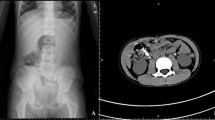Abstract
Since the spring of 2008, an epidemic of urinary tract stones was noted among children in China. This is believed to be associated with consumption melamine-contaminated powdered formula. A few patients presented with acute kidney injury (AKI) due to bilateral renal or ureteral calculi requiring surgical intervention to relieve the obstruction. We retrospectively analyzed clinical and laboratory data, ultrasonograms and treatment methods in children with melamine-induced urolithiasis and AKI who were hospitalized at seven hospitals from September to November 2008 in Gansu Province, China. Treatment given included conservative treatment, cystoscopic or urethroscopic lithotripsy, retrograde ureteral catheterization, ureterolithotomy and nephrostomy. Patients were monitored postoperatively with data of ultrasonography, urinalysis and blood and urine biochemistry. The mean age of the 47 children was 10 months (mean ± SD, 10.83 ± 5.11 months). Thirty-four (72.34%) were male. Calculi size ranged from 3 to 14 mm in diameter. Nine patients (19.15%) were successfully treated with conservative treatment; 32 (68.09%) underwent retrograde ureteral catheterization and eight had simultaneous cystoscopic or urethroscopic stone removal; four were successfully treated with ureterolithotomy, and 1 underwent percutaneous nephrostomy. Thirty-eight patients were followed up for a mean ± SD of 18.50 ± 5.27 months and their renal functions were found to have completely recovered. Five (13.16%) cases had residual renal stones with diameter ranging from 2 to 4 mm. Therefore, this study has demonstrated that melamine-induced urolithiasis could lead to AKI. Removing obstruction promptly by surgical intervention has been found to be effective with satisfactory outcomes observed at mean follow-up period of 18-month. However, residual renal stone remained in 13.16% of the cases which required continued close observation.
Similar content being viewed by others
Abbreviations
- AKI:
-
Acute kidney injury
- BUN:
-
Blood urea nitrogen
- Cr:
-
Creatinine
References
The Central People’s Government of the People’s Republic of China: medical treatment information of Sanlu infant formula milk powder, Ministry of Health of the People’s Republic of China Information Bulletin, 1 December 2008. http://www.gov.cn/gzdt/2008-12/02/content_1165588.htm
Sun N, Shen Y, Sun Q et al (2009) Diagnosis and treatment of melamine-associated urinary calculus complicated with acute renal failure in infants and young children. Chin Med J (Engl) 122(3):245–251
Zhang L, Wu LL, Wang YP et al (2009) Melamine-contaminated milk products induced urinary tract calculi in children. World J Pediatr 5(1):31–35
Sun Q, Shen Y, Sun N et al (2010) Diagnosis, treatment and follow-up of 25 patients with melamine-induced kidney stones complicated by acute obstructive renal failure in Beijing Children’s Hospital. Eur J Pediatr 169(4):483–489
Mehta RL, Kellum JA, Shah SV et al (2007) Acute Kidney Injury Network: report of an initiative to improve outcomes in acute kidney injury. Crit Care 11(2):R31
Guan N, Fan Q, Ding J et al (2009) Melamine-contaminated powdered formula and urolithiasis in young children. N Engl J Med 360:1067–1074
Lam CW, Lan L, Che X et al (2009) Diagnosis and spectrum of melamine-related renal disease: plausible mechanism of stone formation in humans. Clin Chim Acta 402:150–155
http://www.moh.gov.cn/publicfiles/business/htmlfiles/mohbgt/s3582/200812/38386.htm
Langman CB, Alon U, Ingelfinger J et al (2009) A position statement on kidney disease from powdered infant formula-based melamine exposure in Chinese infants. Pediatr Nephrol 24(7):1263–1266
Chan ZCY, Lai WF (2009) Revisiting the melamine contamination event in China: implications for ethics in food technology. Trends Food Sci Technol 20(8):366–373
Brown CA, Jeong KS, Poppenga RH et al (2007) Outbreaks of renal failure associated with melamine and cyanuric acid in dogs and cats in 2004 and 2007. J Vet Diagn Invest 19(5):525–531
Baynes RE, Smith G, Mason SE et al (2008) Pharmacokinetics of melamine in pigs following intravenous administration. Food Chem Toxicol 46:1196–1200
World Health Organization and Food and Agriculture Organization of the United Nations: toxicological and health aspects of melamine and cyanuric acid, report of a WHO expert meeting in collaboration with FAO supported by Health Canada, Health Canada, Ottawa, Canada, 1–4 December 2008. http://whqlibdoc.who.int/publications/2009/9789241597951_eng.pdf
Puschner B, Poppenga RH, Lowenstine LJ et al (2007) Assessment of melamine and cyanuric acid toxicity in cats. J Vet Diagn Invest 19(6):616–624
Dobson RL, Motlagh S, Quijano M et al (2008) Identification and characterization of toxicity of contaminants in pet food leading to an outbreak of renal toxicity in cats and dogs. Toxicol Sci 106(1):251–262
Jia LQ, Shen Y, Wang XM et al (2009) Ultrasonographic diagnosis of urinary calculus caused by melamine in children. Chin Med J (Engl) 122(3):252–253
World Health Organization: food safety. Expert meeting to review toxicological aspects of melamine and cyanuric acid, 1-4 December 2008. http://www.who.int/foodsafety/fs_management/infosan_events/en/index3.html
Panfeng S, Hong C, Zhongjin Y et al (2011) Urolithiasis Induced by melamine-contaminated powdered formula (report of 619 cases). Urology (Epub ahead of print)
Andreoli SP (2009) Acute kidney injury in children. Pediatr Nephrol 24:253–263
Gopaluni S, Lines S, Lewington AJP (2010) Acute kidney injury in the critically ill patient. Curr Anaesth Crit Care 21:60–64
Wen JG, Li ZZ, Zhang H et al (2010) Melamine related bilateral renal calculi in 50 children: single center experience in clinical diagnosis and treatment. J Urol 183:1533–1537
Acknowledgments
The authors would like to thank all the healthcare professionals and patients participating in this study. We acknowledge language support provided by Dr Per Bagi and Dr Joey Kwong. This work was partly supported by the Fundamental Research Funds for the Central Universities of China (No. lzujbky-2010-147 for Z. J. Yue). The grant of Health Scientific Research Projects Program of Gansu province (No. 9622050-01 for Z. J. Yue).
Author information
Authors and Affiliations
Corresponding author
Rights and permissions
About this article
Cite this article
Shang, P., Chang, H., Yue, Z.J. et al. Acute kidney injury caused by consumption of melamine-contaminated infant formula in 47 children: a multi-institutional experience in diagnosis, treatment and follow-up. Urol Res 40, 293–298 (2012). https://doi.org/10.1007/s00240-011-0422-6
Received:
Accepted:
Published:
Issue Date:
DOI: https://doi.org/10.1007/s00240-011-0422-6



